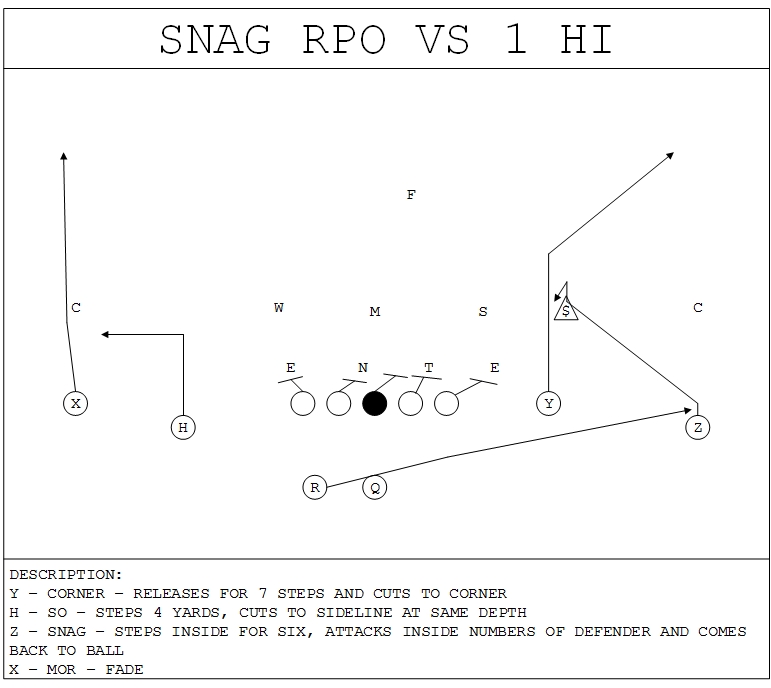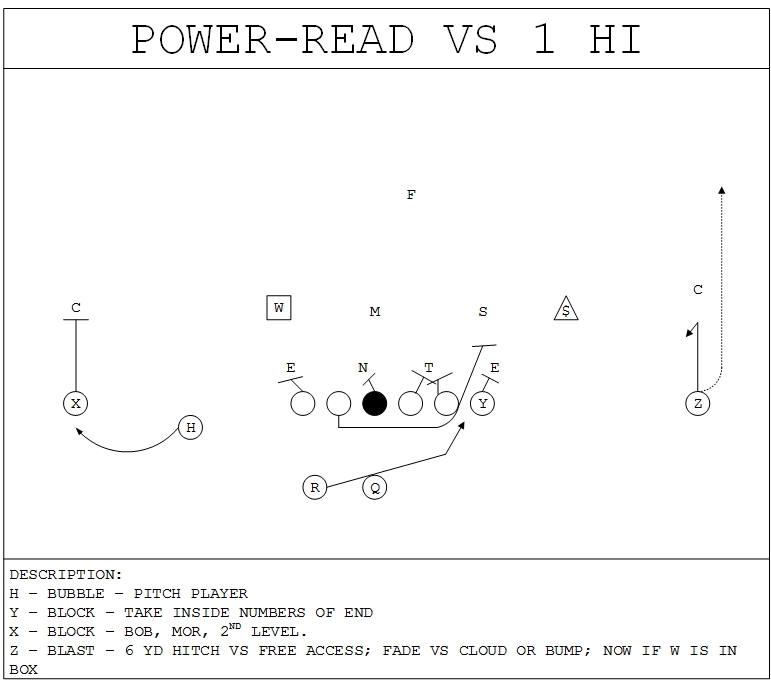Introduction:
Hello. Hope all is going well. In this article, I will be briefly going over three other RPO concepts that I think will be pretty effective in the near future. Some of these concepts like the Search Concept have averaged over 7 yards per play with teams like Abilene Christian University. Others are just wrinkles that offensive coordinators like to toy with to give defenses an extra look. Whatever they may be, they have proven to be effective and I wouldn’t be surprised if they appeared in the NFL as soon as next year.
The team I am working with currently has toyed with running the Search concept. They have went back and forth on it before somewhat, but not quitely, pulling it out of their playbook. I will introduce it to you now because it is effective if you can install it into your offense.
Search vs 2 HI:

Search vs 1 HI:

Search is a derivative of the stick concept. Just like the Stick, the Search aims to suck in the Dive Read and move the Pitch Read away from the play to pick up yards through the middle of the field. It uses the flat route underneath to suck the backer in and then placing a Search route over the top to capitalize on the void. Think of it as a Hi-Lo concept meshed in with a run fake, only now it is a quick game concept meshed with an inside zone read.
The objective of the Search route is to make it look like a traditional triple option pitch. The H and Z are going to show a blocking pattern off the LOS. If the timing is right, they receivers should release into their routes after the run action has occurred in the backfield. This will give the defense a change-up by forcing the S to pick the flat or the search. If the S picks the flat, the QB will throw to H over the top. If the S drops to defend the Search, the QB will hit the flat. It’s very important that the H comes out slow in the initial release of his route because the S has to think he is going out for a block instead of running a route. If he sells the slow speed just right, he will escape the Sam’s periphery and will be open in the void behind him.
The QB will decide whether to keep it based off of the M’s action. If the M dives to the ball, QB will keep it and run to the open (weak) side of the play. If the Mike stays, the QB will hand it off to the RB if the numbers are right. If RB gets the ball, he will read the hips of the play-side guard to determine which hole he will run through. If the guard’s hips are turned right, he will run off the left hip of that same guard. If the guard’s hips are turned left, he will run off the guard’s right hip.
If the offense is facing against a 1- hi scenario as shown below, the QB will read the dive player and then look to the backside of the concept immediately. The X has what our coaching circle calls a “Hang Loose”. If the cornerback is giving the receiver free access, the WR will run hard at the CB’s numbers and hitch back to the QB at six. If the cornerback is bumping the receiver (press) or showing cloud (Cover 2), then the X will run a Fade over the top of him. Since this is an “on an island” scenario, the QB will throw it based on whether he likes the match-up.
Snag:


The Snag alone is a Triangle concept. As with the Stick concept, its objective is to widen and lengthen the defense using three endpoints of routes. It forces the zone movement key (ZMK), or the defender in zone that the concept is trying to stretch, to choose between the snag or the flat. In this case, the ZMK is the Dive Read. While the QB is reading the snag and flat, he is consciously looking to throw the corner. If the safety is late reacting to it, the QB is taught to hit that first. This is known around coaching circles as the advantage principal, or the route that initiates the big play.
Unlike all the others, this RPO is designed to attack the perimeter of the defense not the box of the defense. Therefore, the run read attached to it is now an outside zone as opposed to an inside zone. this also means that the back is free to release to the flat because he no longer has to run up the middle. and is part of the concept now. This is beneficial because the defense has to account for a fifth receiver in the play while also trying to defend him as a runner. The bind this play puts on the defense is extremely unique and adds both leverage and numbers to the equation.
If the offense faces a 2 HI look, the QB will locate the Dive Read and decide whether to hand it off based on his movement. As always if he dives to the RB, the QB will pull it and run to the open side of the concept. If he stays, he will hand it off to the RB if the numbers are right or hitch step to pass it. He will read the S to determine whether to throw to the ball. If the advantage principal (corner) is open, QB is going to throw it right away hoping for the big play.
If the offense faces a 1 HI look, the QB will read the dive key and keep his eyes on the strong side. If he sees a 2 on 1 matchup on the open side, he will flip his eyes to that side and choose the fade or the square-out (SO) based on leverage and depth. If the CB is deep, he will throw the SO, if the CB is within 5 yards, he will throw the fade.
Basic Snag Concept without RPO attached by some QB named Brock Osweiler
Power-Read:


The Power-Read is a wrinkle in the run game to add another number to the strong side of the play. If the defense is playing 2 HI, and they are in a 4 man front, all the offense has to do is pull the guard and they have a 5 on 3 match-up on the strong side of the defense. That’s definitely winning in the numbers department.
Versus that same look, the QB will account for numbers and leverage in his pre-snap evaluation. Afterwards, will analyze the dive read, pull it in when the numbers don’t favor the run, and then read the pitch player to decide whether he wants to keep it or throw it to the bubble.
This will be the same read against 1 HI, except, the QB will key the pitch read pre-snap. If the W is in the box, the QB throws the Now Route without moving to his run read. (The Now Route is not diagrammed into the visuals, it’s a route in which the WR runs directly 5 yards ahead of the LOS over the T. It’s called a “Now” route because the QB is supposed to throw it as soon as he gets the ball).
This is a great perimeter RPO because the pulling guard pulls the backside LB into the run. Once the backside LB is pulled into the run, the open side of the field is well… open because the LB has left his hook/curl responsibility. The X running the backside “Now” route is wide open if the QB wants to pull up and throw quick into the open side.
That’s all for my series on attacking with RPO’s. In my next article, I will be going over the top three ways to defend against the RPO. Thanks for reading and I hope you guys have a great weekend.
My Writing Schedule as of Now:
- Defending against the RPO: The Scrape-Exchange, Bracket Coverage, and Cut Corners
- June 3-6
- The Politics Of Coaching
- June 7-9
- Player Analysis: Brock Osweiler
- June 11-13
- Principles in the Zone Running Scheme: From Zero to Four
- June 15-17